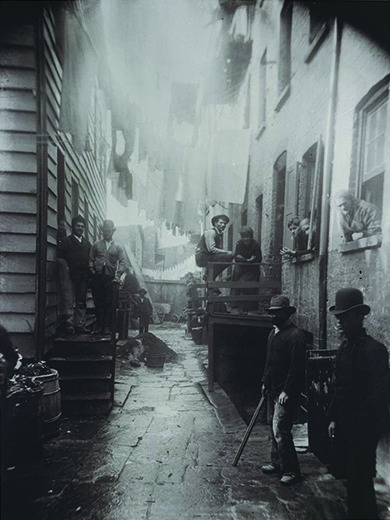Module 3: Industrialization, 1870-1900 & The Growing Pains of Urbanization, 1870-1900
Section outline
-

Image from Chapter 19 in U.S. History from OpenStax, licensed under Creative Commons Attribution License v4.0 with the image information: In photographs such as Bandit’s Roost (1888), taken on Mulberry Street in the infamous Five Points neighborhood of Manhattan’s Lower East Side, Jacob Riis documented the plight of New York City slums in the late nineteenth century.
In this module, you will learn about the inventions and industrialization that helped define American in the last decades of the nineteenth century. You will investigate the business inventions, particularly the communication technologies, electric power production, and steel production. You will examine the leading tycoons of the period, notably Andrew Carnegie, John Rockefeller, and J.P. Morgan, individuals who not only accumulated great wealth, but also revolutionized business management. You will also explore how the tycoons built their wealth on the backs of laborers, who suffered through long hours for low wages in often dangerous conditions. Finally, you will analyze the growth of organized labor, including organizations like the American Federation of Labor and Knights of Labor, in response to the exploitation of workers.
Upon completion of this module, you will be able to:
Industrialization, 1870-1900
- Explain how the ideas and products of late-nineteenth-century inventors contributed to the rise of big business (CO 1-5)
- Explain how the inventions of the late nineteenth century changed everyday American life (CO 1-5)
- Explain how the inventions of the late nineteenth century contributed directly to industrial growth in America (CO 1-5)
- Identify the contributions of Andrew Carnegie, John Rockefeller, and J. P. Morgan to the new industrial order emerging in the late nineteenth century (CO 1-5)
- Describe the visions, philosophies, and business methods of the leaders of the new industrial order (CO 1-7)
- Explain the qualities of industrial working-class life in the late nineteenth century (CO 1-5)
- Analyze both workers’ desire for labor unions and the reasons for unions’ inability to achieve their goals (CO 1-7)
- Describe the characteristics of the new consumer culture that emerged at the end of the nineteenth century (CO 1-7)
The Growing Pains of Urbanization, 1870-1900
- Explain the growth of American cities in the late nineteenth century (CO 1-5)
- Identify the key challenges that Americans faced due to urbanization, as well as some of the possible solutions to those challenges (CO 1-7)
- Identify the factors that prompted African American and European immigration to American cities in the late nineteenth century (CO 1-5)
- Explain the discrimination and anti-immigration legislation that immigrants faced in the late nineteenth century (CO 1-5)
- Identify how each class of Americans—working class, middle class, and upper class—responded to the challenges associated with urban life (CO 1-7)
- Explain the process of machine politics and how it brought relief to working-class Americans (CO 1-5)
- Explain how American writers, both fiction and nonfiction, helped Americans to better understand the changes they faced in the late nineteenth and early twentieth centuries (CO 1-5)
- Identify some of the influential women and African American writers of the era (CO 1-7)
To achieve these objectives:
- Read the Module 3 Introduction above.
- Read and view the materials in Module 3 (click below)
- View the Module 3 PowerPoints below.
- Complete Module 3 quizzes/assignments/discussion boards based on chapter/document reading.
Module Pressbooks Resources and Activities
You will find the following resources and activities in this module at the Pressbooks website. Click on the links below to access or complete each item.
Background Colour
Font Face
Font Kerning
Font Size
Image Visibility
Letter Spacing
Line Height
Link Highlight
Text Colour
